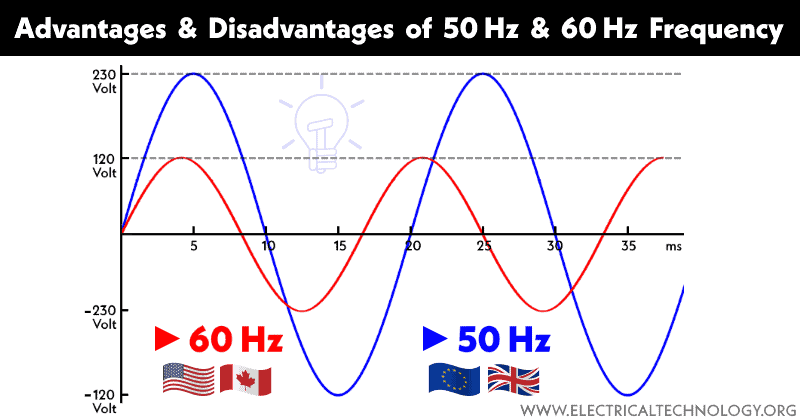Advantages & Disadvantages of 50 Hz and 60 Hz Frequency Power Supply
Advantages and Disadvantages of 60 Hz (US) and 50 Hz (EU) Frequency
We know that the frequency of the supply voltage in North American countries, including Canada and the US, is 60 Hz, while in the UK, EU, and other countries following IEC standards, 50 Hz is used instead. In this article, we will showcase the advantages of each frequency over the other.
Related Posts:
- Difference Between 50 Hz and 60 Hz Frequency System
- Why is the Standard Frequency 60 Hz in the US & 50 Hz in the EU?
Advantages of 50 Hz over 50 Hz Power Supply
There are several advantages of using a 50 Hz frequency over a 60 Hz frequency, including:
Lower Equipment Cost:
Electrical equipment designed for 50 Hz systems is generally less expensive than equipment designed for 60 Hz systems. This is because 50 Hz equipment requires less copper and iron in its construction, leading to reduced material and manufacturing costs.
Reduced Core Losses:
At the same voltage, 50 Hz systems have lower core losses in transformers and other magnetic equipment than 60 Hz systems. This results in increased efficiency and reduced heat generation.
Longer Life for Equipment:
Electrical equipment designed for 50 Hz systems tends to have a longer lifespan than equipment designed for 60 Hz systems. This is because the lower frequency reduces the stress on equipment, resulting in less wear and tear over time.
Better Power Transmission:
50 Hz systems are better suited for long-distance power transmission than 60 Hz systems. This is because 50 Hz systems experience less line loss, which is the loss of electrical energy as it travels through transmission lines.
More Efficient Motors:
Electric motors designed for 50 Hz systems tend to be more efficient than motors designed for 60 Hz systems. This is because the lower frequency reduces the amount of current needed to generate the same amount of power, resulting in lower energy consumption and cost.
Related Posts:
- Which One is More Dangerous? 50Hz or 60Hz in 120V/230V & Why?
- Which Transformer is More Efficient When Operates on 50Hz or 60Hz?
Advantages of 60 Hz over 50 Hz Power Supply
Following are the advantages of using a power supply having 60 Hz of frequency over a 50 Hz frequency.
Smaller and Lighter Equipment:
Electrical equipment designed for 60 Hz systems is generally smaller and lighter than equipment designed for 50 Hz systems. This is because 60 Hz equipment requires fewer turns of wire in its construction, leading to smaller transformers and motors.
Higher Motor Speeds:
Electric motors designed for 60 Hz systems can achieve higher speeds than motors designed for 50 Hz systems. This can be advantageous for certain applications, such as air conditioning and refrigeration, where higher motor speeds are needed to achieve optimal performance.
Better Arcing Performance:
At the same voltage, 60 Hz systems have better arc suppression performance than 50 Hz systems. This can be important for safety reasons, as arcs can cause equipment damage, fires, and electrical shocks.
Better Audio Quality:
Audio systems designed for 60 Hz systems tend to have better sound quality than systems designed for 50 Hz systems. This is because the higher frequency allows for better filtering of noise and interference, resulting in clearer sound.
More Common in North America: 60 Hz is the standard frequency used in North America including US and Canada, so using a 60 Hz system can be advantageous for compatibility and ease of integration with existing infrastructure.
Related Posts:
- Can We Operate a 60Hz Transformer on 50Hz Supply Source and Vice Versa?
- Is it Possible to Operate a 50Hz Transformer on 5Hz or 500Hz Frequency?
As a comparison, following are the advantages and disadvantages of both 60 Hz and 50 Hz frequencies.
- A motor will have a 20 % higher speed on a 60 Hz power supply as compared to a 50 Hz power supply.
- The cooling of a machine is better at 60 Hz than at 50 Hz because speed depends on frequency.
- The torque at 50 Hz is larger as compared to the 60 Hz.
- The lifetime of bearings is lower at 60 Hz as compared to 50 Hz.
- The sizes of electrical machines are larger at 50 Hz as compared to 60 Hz.
- A 50 Hz power system has a slightly higher power factor than 60 Hz for the same machine.
- A power system having 50 Hz of frequency reduces the constant and variable power losses in machines as compared to 60 Hz machines.
- The humming noise is high at 60 Hz than at 50 Hz.
- 120V at 60 Hz frequency requires a large size conductor as compared to 230V, 50 Hz frequency system.
- a 50 Hz power system has lower corona losses as compared to a 60 Hz power system.
- A 60 Hz system needs more insulation than a 50 Hz system.
- The overall efficiency of the machines are greater in 50 Hz as compared to 60 Hz.
Related Interesting and Informative Questions & Answers:
- Which One is More Dangerous And Why? AC or DC ?
- Which One is More Dangerous? 120V or 230V and Why?
- Chart List of Standard Voltage and Frequency Around the World
- Why is the Standard Voltage in the US 120V/240V and 230V in the EU?
- Difference Between 120V and 240V/230V AC Power Supply
- Difference Between Current and Voltage
- Difference between AC and DC (Current & Voltage)
- Difference Between Single Phase and Three Phase Power Supply
- Why 3-Phase Power? Why Not 6, 12 or More for Power Transmission?
- If a 1-Phase Supply is 230V, Why is 3-Phase 400V & Not 690V?
- Difference Between Socket, Outlet and Receptacle
- Why Do Prongs in Electrical Plugs Have Holes in Them?
- Why Don’t Birds and Squirrels Get Electrocuted on Power Lines?
- Why are Salt and Charcoal Added in Earthing Pit for Grounding?
- What are the Colored Aerial Marker Balls on Power Lines For?
- Which Bulb Glows Brighter When Connected in Series and Parallel & Why?
- Why Can’t a 12V Car Battery Electrocute You?
- Stranded Wire vs Solid Wire. Which One is Best and Why?
- Why are US Homes Wired Using Solid Wire rather than Stranded Wire?







